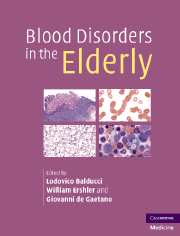Book contents
- Frontmatter
- Contents
- List of contributors
- Preface
- Part I Epidemiology
- 1 Epidemiology of aging
- 2 Epidemiology of anemia in older adults
- 3 Cancer in the older person: a comprehensive approach
- 4 From fitness to frailty: toward a nosologic classification of the older aged person
- Part II Hematopoiesis
- Part III Anemia of aging
- Part IV Hematologic malignancies and aging
- Part V Disorders of hemostasis in the elderly
- Index
2 - Epidemiology of anemia in older adults
from Part I - Epidemiology
Published online by Cambridge University Press: 21 October 2009
- Frontmatter
- Contents
- List of contributors
- Preface
- Part I Epidemiology
- 1 Epidemiology of aging
- 2 Epidemiology of anemia in older adults
- 3 Cancer in the older person: a comprehensive approach
- 4 From fitness to frailty: toward a nosologic classification of the older aged person
- Part II Hematopoiesis
- Part III Anemia of aging
- Part IV Hematologic malignancies and aging
- Part V Disorders of hemostasis in the elderly
- Index
Summary
Introduction
The US Census Bureau enumerated 35.0 million adults aged 65 years and older in the 2000 decennial census. Older adults comprised 12.4% of the total US population. By 2050, this segment is projected to grow to 86.7 million, and one out of every five persons will be elderly. Further, the oldest old (those 85 years and older) will grow approximately 400% and represent the fastest-growing age group in the USA. However, the USA is not alone in experiencing population aging, and in fact it is now ranked the 38th oldest country. While population aging is occurring in all regions of the world, rapid declines in fertility rates have generated faster growth rates in the proportion of older adults in developing countries than in developed ones. In view of global population aging and the multiple morbidities associated with aging, the prevention and treatment of conditions that impair functional capacity and quality of life is a major priority of geriatric medicine.
Anemia is a common hematologic condition among older adults, with prevalence estimates increasing as a function of age. Contrary to widely held beliefs that anemia is an innocuous condition of old age, recent evidence suggests that anemia does not reflect a normal aging process, but rather is a marker of underlying pathology and/or a cause of further physiological dysregulation.
- Type
- Chapter
- Information
- Blood Disorders in the Elderly , pp. 11 - 20Publisher: Cambridge University PressPrint publication year: 2007
- 3
- Cited by



